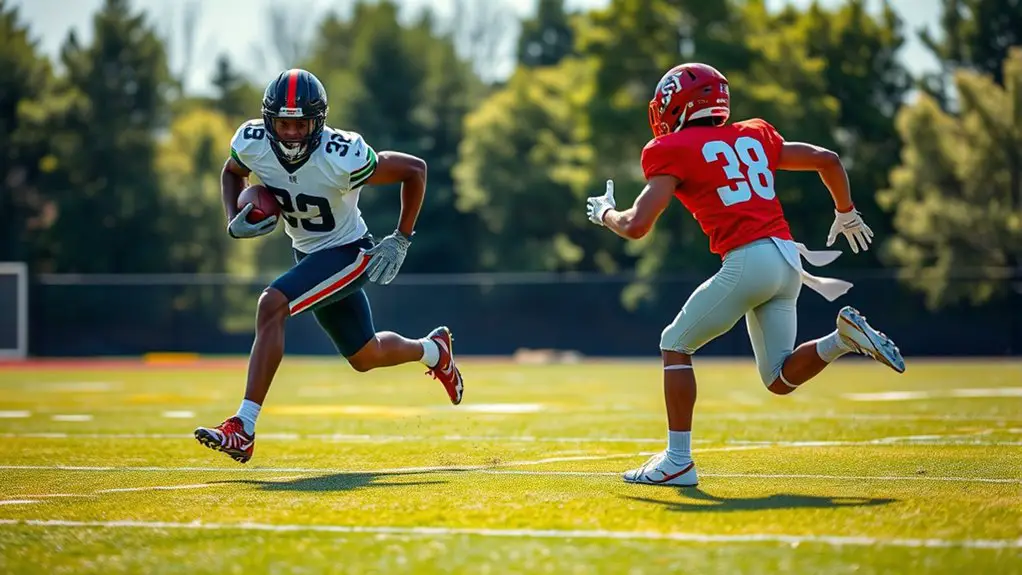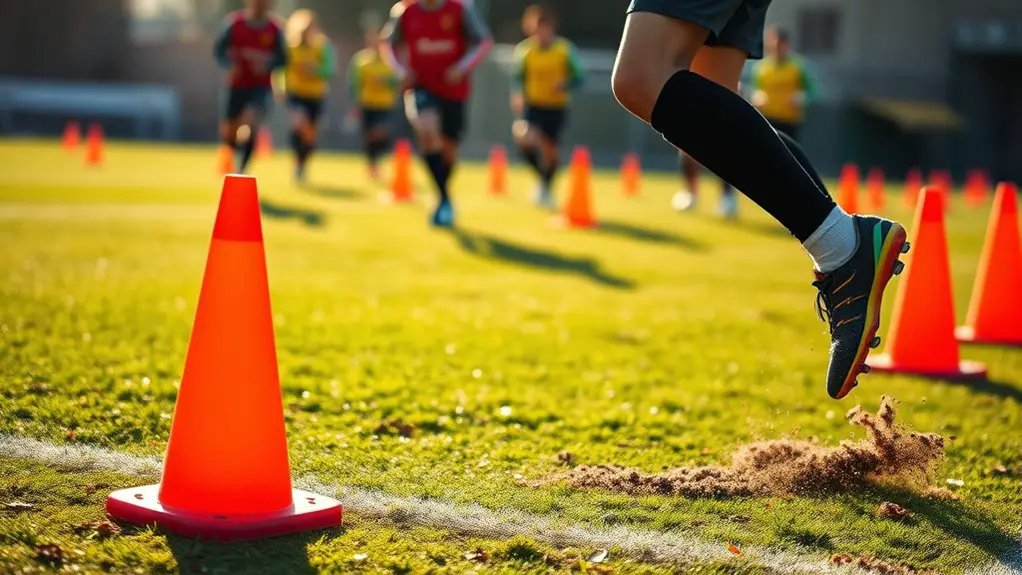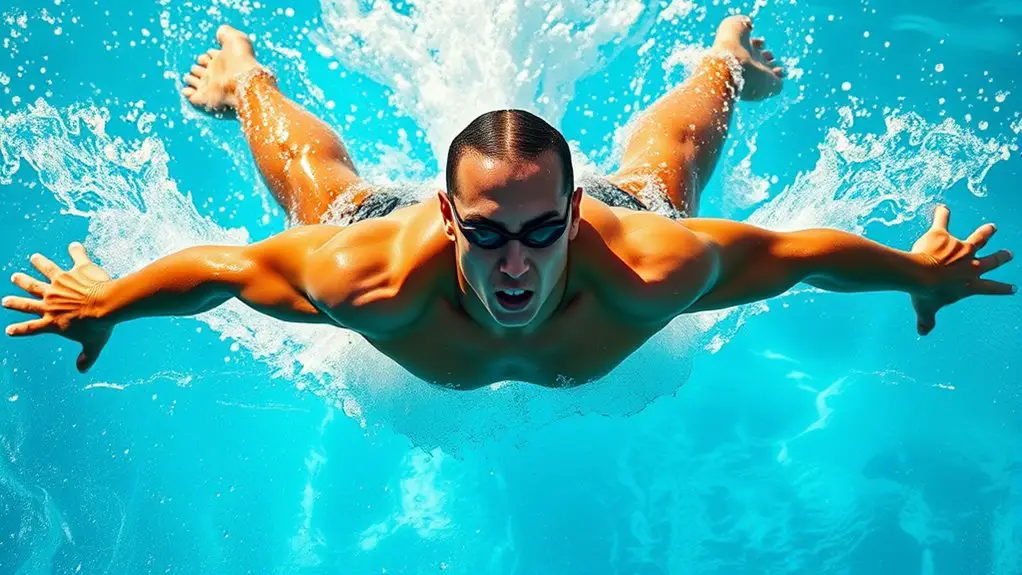Advanced footwork drills can sharpen your skills as a wide receiver or cornerback, giving you the edge on the field. Incorporate ladder drills to enhance agility and foot speed. Use cone drills for improving your change of direction and reaction time. Emphasize your stance, backpedaling, and hip movement to maximize efficiency. Regular practice will boost your confidence and performance during games. Discover more about effective drills that can elevate your game even further.
Importance of Footwork in Football
Footwork is essential in football, serving as the foundation for effective play. Understanding footwork mechanics isn't just about moving your feet; it's about creating freedom in your game. When you master the nuances of your footwork, you unleash your potential to maneuver swiftly and decisively, whether you're a receiver or a defender. An importance analysis of footwork reveals its critical role in maintaining balance, agility, and speed. Every cut, pivot, and sprint relies on how well you position your feet. Without solid footwork, you're limiting your ability to evade opponents or execute precise routes. You want to dominate the field, right? So, embrace the art of footwork and watch your performance soar. Remember, it's not just about the big plays; it's the small, deliberate movements that can make all the difference, giving you the freedom to express your unique style on the field. Moreover, agility training techniques can significantly enhance your footwork and overall performance on the field.
Essential Footwork Techniques for Wide Receivers
To excel as a wide receiver, mastering your stance is essential for a solid foundation. You'll also need quick release techniques to gain those important yards right off the line. Finally, precision in your routes can make all the difference in creating separation from defenders. Incorporating agility ladder drills into your training regimen can significantly enhance your foot speed and coordination, which are crucial for success on the field.
Start With Stance
A solid stance is essential for wide receivers aiming to maximize their footwork and quickness on the field. Your starting position sets the tone for every route you'll run. Focus on stance fundamentals: keep your feet shoulder-width apart, with your knees slightly bent, and weight balanced on the balls of your feet. This allows for explosive movements in any direction. Keep your back straight and your head up, staying aware of the field and defenders. A relaxed, yet controlled stance enables you to react instinctively while creating separation from defenders. Remember, the right stance is your foundation; it's where your agility and speed begin. Embrace these basics, and you'll reveal your potential as a dynamic playmaker.
Quick Release Techniques
Mastering quick release techniques is vital for wide receivers who want to gain an edge over defenders right off the line. To achieve this, focus on your foot placement and explosive movements. Start with a balanced stance, then utilize a powerful first step to break free from the line of scrimmage. Timing mechanics play a significant role here; refine your muscle memory to guarantee your movements are fluid and instinctive. Practice drills that emphasize acceleration and quick footwork, such as releasing off cones or against a defender. Remember, the quicker you can disengage from a press, the more freedom you'll have to create separation and make plays. Embrace these techniques, and you'll elevate your game to new heights.
Route Precision Drills
Perfecting route precision is essential for wide receivers aiming to outsmart defenders and create opportunities on the field. To elevate your game, focus on drills that enhance your route running and guarantee those precision cuts are sharp. Start with cone drills that simulate game scenarios, allowing you to practice tight turns and explosive sprints. Incorporate ladder drills to boost your foot speed and coordination, making those quick shifts second nature. Pair these exercises with visual cues, like a coach's whistle or a partner's signal, to improve your reaction time. Remember, the goal is to maintain balance while executing your cuts, maximizing separation from defenders. Commit to these drills, and you'll see your precision and effectiveness soar!
Key Footwork Skills for Cornerbacks
Effective footwork is essential for cornerbacks, as it can make the difference between successfully defending a pass or getting burned by a receiver. To elevate your game, focus on mastering hip movement drills, which enhance your agility and responsiveness. These drills help you pivot smoothly and maintain balance while staying aggressive.
Incorporating backpedal techniques is vital, too. A strong backpedal allows you to quickly shift from coverage to pursuit, keeping you in the right position to challenge wide receivers. When practicing your backpedal, aim for a low center of gravity and keep your feet light and quick. Additionally, remember that proper footwork reduces the risk of sprains and strains, allowing for a safer and more effective performance on the field.
Drill 1: Ladder Drills for Agility
Ladder drills are a fantastic way to boost your agility and foot speed, essential attributes for both wide receivers and cornerbacks. These drills incorporate various ladder variations, allowing you to mix things up and keep your training fresh. Try out lateral shuffles, in-and-out steps, or single-leg hops to engage different muscle groups and enhance your coordination.
As you practice, focus on your foot placement and quickness. You'll notice significant agility benefits that translate directly to your performance on the field. The faster your feet move, the quicker you can change direction, evade defenders, or close gaps. Incorporating ladder drills for quick feet into your routine a few times a week, and challenge yourself to increase speed with every session. You'll not only feel more agile, but you'll also gain the confidence to make those game-time moves with ease. So grab that ladder and get started—you'll thank yourself later!
Drill 2: Cone Drills for Change of Direction
For effective cone drills, you'll need a few cones and enough space to set them up. These drills can be adapted with various techniques to challenge your change of direction skills. Let's explore the different setups and variations you can use to maximize your training.
Setup and Equipment
Setting up cone drills for change of direction is vital for honing agility in both wide receivers and cornerbacks. You'll need a flat training surface, like a grass field or turf, to maximize movement potential. Grab around five cones for your setup, placing them in a zigzag pattern spaced about five yards apart. This configuration encourages quick pivots and explosive cuts, essential for developing your footwork. Make certain you have plenty of field space to move freely without obstruction. Before you start, verify the cones are secure and won't tip over during your drills. With the right setup, you'll create an environment that challenges your agility and enhances your performance on the field.
Drill Variations and Techniques
Cone drills are a great way to enhance your change of direction skills, essential for both wide receivers and cornerbacks. To start, set up a series of cones in various patterns—triangles, squares, or zigzags. As you navigate through these setups, focus on your footwork feedback techniques; listen to your body and adjust your movements for maximum efficiency. Incorporate drill progression strategies by gradually increasing the complexity of the patterns or adding a defender to simulate game situations. This not only boosts your agility but also sharpens your decision-making. Remember, the key is to stay light on your feet and remain balanced, so you can explode in any direction when the play unfolds. Enjoy the freedom in your movements!
Incorporating Footwork Drills Into Practice Sessions
While incorporating footwork drills into practice sessions may seem straightforward, it's essential to tailor them to the specific needs of wide receivers and cornerbacks. This session integration helps players refine their skills and enhances overall performance. Here are some effective practice strategies:
| Drill Type | Focus Area |
|---|---|
| Ladder Drills | Agility and Speed |
| Cone Drills | Directional Change |
| Shadow Drills | Reaction Time |
| Zig-Zag Drills | Balance and Control |
Frequently Asked Questions
How Can Footwork Improve Overall Performance in Games?
Improving your footwork can greatly boost your overall performance in games. When you focus on your technique, you enhance your reaction time, allowing you to respond quicker in dynamic situations. Plus, better footwork leads to agility enhancement, making it easier for you to change direction or evade opponents. This freedom of movement not only elevates your game but also brings confidence, letting you play with greater intensity and creativity on the field.
What Age Should Players Start Focusing on Footwork Drills?
Imagine a tree, strong and sturdy, but its roots must first take hold in the soil. Similarly, you should start focusing on footwork drills during your youth development, ideally around ages 8 to 10. This training age allows you to build a solid foundation while giving you the freedom to explore your skills. As you grow, those early lessons will support your performance, helping you reach new heights in your game.
How Often Should Footwork Drills Be Practiced?
You'll want to incorporate footwork drills into your routine regularly for the best results. Aim for at least three to four sessions a week, adjusting based on your practice schedules and personal goals. Consistent practice helps build muscle memory, so don't shy away from mixing up your frequency guidelines as needed. Ultimately, it's about finding a balance that keeps you engaged while honing your skills. Enjoy the freedom to customize your training!
Can Footwork Drills Prevent Injuries During Games?
You might say footwork drills are like a safety net, subtly protecting you during those high-stakes moments. They're not just about finesse; they're essential for injury prevention. When you refine your movements through biomechanics analysis, you're not only improving your game but also reducing the risk of mishaps. So, embrace those drills, and you'll find yourself dancing through the field with greater agility and freedom, all while keeping those pesky injuries at bay.
What Footwear Is Best for Footwork Training?
When you're considering footwear for footwork training, cleat selection is essential. Choose cleats that offer good traction on various training surfaces, whether it's grass, turf, or indoor floors. The right fit and support will enhance your agility and stability, allowing you to move freely without fear of slipping or injury. Remember, investing in quality footwear can elevate your performance and help you enjoy training to the fullest. Don't underestimate its impact!




